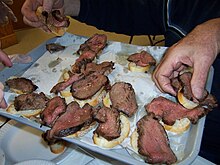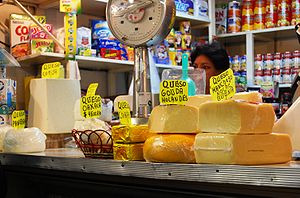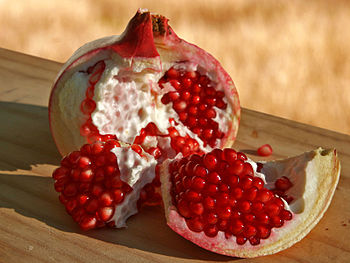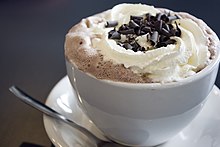Portal:Food
F o o d
A portal dedicated to food and foodways
Introduction


Food is any substance consumed by an organism for nutritional support. Food is usually of plant, animal, or fungal origin and contains essential nutrients such as carbohydrates, fats, proteins, vitamins, or minerals. The substance is ingested by an organism and assimilated by the organism's cells to provide energy, maintain life, or stimulate growth. Different species of animals have different feeding behaviours that satisfy the needs of their metabolisms and have evolved to fill a specific ecological niche within specific geographical contexts.
Omnivorous humans are highly adaptable and have adapted to obtain food in many different ecosystems. Humans generally use cooking to prepare food for consumption. The majority of the food energy required is supplied by the industrial food industry, which produces food through intensive agriculture and distributes it through complex food processing and food distribution systems. This system of conventional agriculture relies heavily on fossil fuels, which means that the food and agricultural systems are one of the major contributors to climate change, accounting for as much as 37% of total greenhouse gas emissions. (Full article...)
Cooking, also known as cookery or professionally as the culinary arts, is the art, science and craft of using heat to make food more palatable, digestible, nutritious, or safe. Cooking techniques and ingredients vary widely, from grilling food over an open fire, to using electric stoves, to baking in various types of ovens, reflecting local conditions. Cooking is an aspect of all human societies and a cultural universal.
Preparing food with heat or fire is an activity unique to humans. Archeological evidence of cooking fires from at least 300,000 years ago exists, but some estimate that humans started cooking up to 2 million years ago.
The expansion of agriculture, commerce, trade, and transportation between civilizations in different regions offered cooks many new ingredients. New inventions and technologies, such as the invention of pottery for holding and boiling of water, expanded cooking techniques. Some modern cooks apply advanced scientific techniques to food preparation to further enhance the flavor of the dish served. (Full article...)

A beefsteak is a type of banquet in which sliced beef tenderloin is served to diners as all-you-can-eat finger food. The dining style originated in 19th-century New York City as a type of working-class celebration but went into a decline in the mid-20th century. Resurrected by caterers in New Jersey, the beefsteak banquet style remained popular in that state's Bergen and Passaic counties, and is enjoying a revival in New York City, where the style originated, due to the reemergence of a biannual beefsteak in Brooklyn. Similar "beef and beer fundraisers" are common in the Philadelphia region, especially in white working class communities. (Full article...)
Selected article –

Cheeses in Mexico have a history that begins with the Spanish conquest, as dairy products were unknown in pre-Columbian Mesoamerica. The Spanish brought dairy animals, such as cattle, sheep, and goats, as well as cheesemaking techniques. Over the colonial period, cheesemaking was modified to suit the mixed European and indigenous tastes of the inhabitants of New Spain, varying by region. This blending and variations have given rise to a number of varieties of Mexican cheeses. These are most popular in the country, although European cheeses are made, as well. Almost all cheese in Mexico is made with cows’ milk, with some made from goats’ milk. More recently, efforts have been made to promote sheep's milk cheeses. Most cheeses are made with raw (unpasteurized) milk. Cheeses are made in the home, on small farms or ranches, and by major dairy product firms. Between 20 and 40 different varieties of cheese are made in Mexico, depending on how one classifies them. Some, such as Oaxaca and panela, are made all over Mexico, but many are regional cheeses known only in certain sections on the country. Some of the least common are in danger of extinction. (Full article...)
Selected cuisine -
Lebanese cuisine is the culinary traditions and practices originating from Lebanon. It includes an abundance of whole grains, fruits, vegetables, fresh fish and seafood. Poultry is eaten more often than red meat, and when red meat is eaten, it is usually lamb and goat meat. Dishes include copious amounts of garlic and olive oil, and dishes are often seasoned with salt and lemon juice. Chickpeas and parsley are also staples of the Lebanese diet.
Well-known dishes include baba ghanouj, tabbouleh, sfeeha, falafel and shawarma. An important component of many Lebanese meals is hummus, a chickpea puree dish, and many dishes are eaten with flatbread. A plate of veggies with tomatoes, cucumber, mint, olives and pickles is always served on table, and a plat of fruits at the end of the meal with a Lebanese coffee. Well-known desserts include baklawa, sfouf and ka'ak. Some desserts are specifically prepared on special occasions; for example, meghli (rice pudding dessert, spiced with anise, caraway, and cinnamon) is served to celebrate a newborn baby in the family. (Full article...)
Selected ingredient –
Whipped cream, also known as Chantilly cream or crème Chantilly (French: [kʁɛm ʃɑ̃tiji]), is high-fat dairy cream that has been aerated by whisking until it becomes light, fluffy, and capable of holding its shape. This process incorporates air into the cream, creating a semi-solid colloid. It is commonly sweetened with white sugar and sometimes flavored with vanilla. Whipped cream is often served on desserts and hot beverages, and used as an ingredient in desserts. (Full article...)
Selected recipe –

In Vietnamese cuisine, bánh mì or banh mi (/ˈbɑːn miː/, /ˈbæn/; Vietnamese: [ɓǎjŋ̟ mì], 'bread') is a short baguette with thin, crisp crust and a soft, airy texture. It is often split lengthwise and filled with meat and savory ingredients like a submarine sandwich and served as a meal, called bánh mì thịt. Plain bánh mì is also eaten as a staple food.
A typical Vietnamese roll or sandwich is a fusion of meats and vegetables from native Vietnamese cuisine such as chả lụa (Vietnamese sausage), coriander (cilantro), cucumber, pickled carrots, and pickled daikon combined with condiments from French cuisine such as pâté, along with red chili and mayonnaise. However, a variety of popular fillings are used, like xá xíu (Chinese barbecued pork), xíu mại Vietnamese minced pork, and nem nướng grilled pork sausage, to even ice cream which are more of a dessert. In Vietnam, bread rolls and sandwiches are typically eaten for breakfast, or as a snack. (Full article...)
Elinor Fettiplace (born Elinor Poole, later Elinor Rogers; c.1570 – in or after 1647) was an English cookery book writer. Probably born in Pauntley, Gloucestershire into an upper-class land-owning farming family, she married into the well-connected Fettiplace family and moved to a manor house in the Vale of White Horse (then in Berkshire, now in Oxfordshire).
In common with many ladies of the Elizabethan era, Fettiplace wrote a manuscript book. It is now known under the title Elinor Fettiplace's Receipt Book, with details of recipes for dishes and meals, medical remedies and tips for running the household. She dated the work 1604, but it is possible that she began writing it several years earlier, when she was still living with her mother. The book was passed down through her family, initially to her niece, until it was handed to the husband of the twentieth-century writer Hilary Spurling. Spurling conducted research on Fettiplace's identity and the contents of the book, and published the work in 1986. (Full article...)
Selected image –

Selected biography –
B. 10 August 1814 – d. 7 July 1890
Henri Nestlé (French pronunciation: [ɑ̃ʁi nɛsle]; born Heinrich Nestle, German: [ˈhaɪnrɪç ˈnɛstlə]; 10 August 1814 – 7 July 1890) was a German-Swiss confectioner and the founder of Nestlé, the world's largest food and beverage company. (Full article...)
Did you know (auto-generated) –

- ... that Miles Hadfield ensured supplies of food to Coventry during the Second World War Blitz?
- ... that within the Armenian Rite, it takes 40 days and more than 40 flowers, herbs, and spices to create the chrism known as myron?
- ... that Binggrae, a South Korean food and beverage company, was the official ice cream supplier of the 1988 Seoul Olympics?
- ... that a two-year-old food bank contributed 150 semi-trucks of supplies to relief efforts for Hurricane Katrina?
- ... that Jean Webster daily served hundreds of people free food directly out of her home kitchen for over a decade?
- ... that the Ni'isjoohl totem pole was once fed a diet of vacuum-packed food?
More did you know –
Related portals
Food topics
The following are topics relating to food
Categories
Food list articles
- See also: Lists of foods and Category:Lists of drinks
The following are some Food list articles on Wikipedia:

- American cheeses
- Appellation d'Origine Contrôlée cheeses
- Apple cultivars
- Bacon dishes
- Bacon substitutes
- Basil cultivars
- Breads
- Breakfast beverages
- Breakfast cereals
- Breakfast foods
- British cheeses
- Cakes
- Candies
- Cheeses
- Cheese soups
- Christmas dishes (list)
- Cocktails
- Cookies
- Dishes using coconut milk
- Diets
- Doughnut varieties
- Egg dishes
- Fermented soy products
- Food additives
- Food additives (Codex Alimentarius)
- Foods named after people
- French cheeses
- French dishes
- Fried dough foods
- Fruits
- List of hamburgers
- Herbs and spices
- Hors d'oeuvre
- Indian dishes
- Indian snack foods
- Indonesian dishes
- Italian dishes
- Japanese snacks
- Japanese dishes
- Jewish dishes
- Kebabs
- Korean beverages
- Mango cultivars
- Moroccan dishes
- Pasta
- Pastries
- Philippine snack food
- Pies, tarts and flans
- Poppy seed pastries and dishes
- Potato dishes
- Puddings
- Raw fish dishes
- Rice dishes
- Rolled foods
- Sauces
- Seafood
- Seeds
- Sandwiches
- Snack foods
- Soft drinks by country
- Soul foods and dishes
- Soups
- Stews
- Street foods
- Tapas
- Turkish dishes
- Twice-baked foods
- Vegetable oils
- Vegetables
- Vodkas
Things you can do
Related WikiProjects
| Parent project: WikiProject Food and Drink | |
| Child projects: | Task forces: (All inactive) |
|
|
| Related projects: | |
New articles
Rules | Match log | Results page (for watching) | Last updated: 2024-11-25 19:21 (UTC)
Note: The list display can now be customized by each user. See List display personalization for details.
- Bankeir, British Columbia (edit | talk | history | links | watch | logs | tools) by DMBanks1 (talk · contribs · new pages (1)) started on 2024-11-25, score: 10
- Bansh (edit | talk | history | links | watch | logs | tools) by LittleT889 (talk · contribs · new pages (1)) started on 2024-11-25, score: 10
- Medallion (food) (edit | talk | history | links | watch | logs | tools) by Noble Attempt (talk · contribs · new pages (19)) started on 2024-11-25, score: 10
- Wei Tchou (edit | talk | history | links | watch | logs | tools) by Phibeatrice (talk · contribs · new pages (178)) started on 2024-11-24, score: 10
- Milco (edit | talk | history | links | watch | logs | tools) by Abishe (talk · contribs · new pages (64)) started on 2024-11-24, score: 20
- Lily O'Brien's (edit | talk | history | links | watch | logs | tools) by Newbydge (talk · contribs · new pages (6)) started on 2024-11-23, score: 10
- The Protein Works (edit | talk | history | links | watch | logs | tools) by Taylordanrw (talk · contribs · new pages (1)) started on 2024-11-22, score: 20
- Give Me a Band and a Bandana (edit | talk | history | links | watch | logs | tools) by Rn.brito (talk · contribs · new pages (4)) started on 2024-11-23, score: 10
- Vaillant's smooth-head (edit | talk | history | links | watch | logs | tools) by Quetzal1964 (talk · contribs · new pages (122)) started on 2024-11-23, score: 10
- Ya dong (edit | talk | history | links | watch | logs | tools) by Paul 012 (talk · contribs · new pages (13)) started on 2024-11-23, score: 10
- Suan la fen (edit | talk | history | links | watch | logs | tools) by 8UB3RG1N3 (talk · contribs · new pages (3)) started on 2024-11-23, score: 10
- Kuanfen noodles (edit | talk | history | links | watch | logs | tools) by 8UB3RG1N3 (talk · contribs · new pages (3)) started on 2024-11-22, score: 10
- 8424 watermelon (edit | talk | history | links | watch | logs | tools) by CanonNi (talk · contribs · new pages (19)) started on 2024-11-22, score: 10
- Chloronitramide anion (edit | talk | history | links | watch | logs | tools) by Mrfoogles (talk · contribs · new pages (10)) started on 2024-11-21, score: 10
- Candia (brand) (edit | talk | history | links | watch | logs | tools) by Leeanah (talk · contribs · new pages (16)) started on 2024-11-21, score: 10
- The Return of Don Quixote (edit | talk | history | links | watch | logs | tools) by Justinkrivers (talk · contribs · new pages (3)) started on 2024-11-21, score: 10
- Portland Cider Company (edit | talk | history | links | watch | logs | tools) by Another Believer (talk · contribs · new pages (76)) started on 2024-11-20, score: 10
- Four Faultless Felons (edit | talk | history | links | watch | logs | tools) by Justinkrivers (talk · contribs · new pages (3)) started on 2024-11-17, score: 10
- 290 (disambiguation) (edit | talk | history | links | watch | logs | tools) by 88.235.214.122 (talk · contribs · new pages (13)) started on 2024-11-12, score: 20
- 287 (disambiguation) (edit | talk | history | links | watch | logs | tools) by 88.235.214.122 (talk · contribs · new pages (13)) started on 2024-11-12, score: 20
- D82 (edit | talk | history | links | watch | logs | tools) by 88.235.214.122 (talk · contribs · new pages (13)) started on 2024-11-12, score: 20
- 901 (disambiguation) (edit | talk | history | links | watch | logs | tools) by 88.235.214.122 (talk · contribs · new pages (13)) started on 2024-11-12, score: 20
- Ian Macleod Distillers (edit | talk | history | links | watch | logs | tools) by Angryskies (talk · contribs · new pages (2)) started on 2024-11-20, score: 10
- Tibet Development Company (edit | talk | history | links | watch | logs | tools) by TinaLees-Jones (talk · contribs · new pages (87)) started on 2024-11-20, score: 20
- Jam Jams (edit | talk | history | links | watch | logs | tools) by 74.3.135.94 (talk · contribs · new pages (3)) started on 2024-11-18, score: 20
- David R. Chan (edit | talk | history | links | watch | logs | tools) by Mikeblas (talk · contribs · new pages (4)) started on 2024-11-18, score: 10
- Murad Al-Katib (edit | talk | history | links | watch | logs | tools) by Mary Mark Ockerbloom (talk · contribs · new pages (8)) started on 2024-11-16, score: 10
- Sofi Malt SE (edit | talk | history | links | watch | logs | tools) by AsteriodX (talk · contribs · new pages (20)) started on 2024-11-17, score: 10
- Clinking glasses (edit | talk | history | links | watch | logs | tools) by Викидим (talk · contribs · new pages (9)) started on 2024-11-16, score: 10
- Look at This Blue (edit | talk | history | links | watch | logs | tools) by Phibeatrice (talk · contribs · new pages (178)) started on 2024-11-15, score: 10
- Kosher slaughterer (edit | talk | history | links | watch | logs | tools) by Boxes12 (talk · contribs · new pages (8)) started on 2024-11-15, score: 10
- Pflaumentoffel (edit | talk | history | links | watch | logs | tools) by Thriley (talk · contribs · new pages (113)) started on 2024-11-15, score: 10
- CTV Specialty Television (edit | talk | history | links | watch | logs | tools) by 76.67.94.153 (talk · contribs · new pages (1)) started on 2024-11-15, score: 10
- Dry fruits (edit | talk | history | links | watch | logs | tools) by WikieMouse (talk · contribs · new pages (2)) started on 2024-11-15, score: 20
- Mahura flower (edit | talk | history | links | watch | logs | tools) by Ameliahill08 (talk · contribs · new pages (2)) started on 2024-11-14, score: 10
- Nuts.com (edit | talk | history | links | watch | logs | tools) by Thriley (talk · contribs · new pages (113)) started on 2024-11-14, score: 20
- Alexei Zimin (edit | talk | history | links | watch | logs | tools) by No Swan So Fine (talk · contribs · new pages (8)) started on 2024-11-14, score: 10
- Ghost (company) (edit | talk | history | links | watch | logs | tools) by Thriley (talk · contribs · new pages (113)) started on 2024-11-13, score: 10
- Dhayalan Mohanasundaram (edit | talk | history | links | watch | logs | tools) by Ashwinijaya09 (talk · contribs · new pages (1)) started on 2024-11-13, score: 20
- 2025 NHRA Mission Foods Drag Racing Series (edit | talk | history | links | watch | logs | tools) by Racecarz (talk · contribs · new pages (1)) started on 2024-11-12, score: 10
- Fleshy fruit (edit | talk | history | links | watch | logs | tools) by WikieMouse (talk · contribs · new pages (2)) started on 2024-11-12, score: 10
- Kaak (bread) (edit | talk | history | links | watch | logs | tools) by Paraw (talk · contribs · new pages (1)) started on 2024-11-12, score: 30
- Mao tofu (edit | talk | history | links | watch | logs | tools) by Cs california (talk · contribs · new pages (8)) started on 2024-11-12, score: 10
- CorkScrew BBQ (edit | talk | history | links | watch | logs | tools) by Another Believer (talk · contribs · new pages (76)) started on 2024-11-12, score: 10
- LeRoy and Lewis Barbecue (edit | talk | history | links | watch | logs | tools) by Another Believer (talk · contribs · new pages (76)) started on 2024-11-12, score: 10
- La Barbecue (edit | talk | history | links | watch | logs | tools) by Another Believer (talk · contribs · new pages (76)) started on 2024-11-12, score: 10
- InterStellar BBQ (edit | talk | history | links | watch | logs | tools) by Another Believer (talk · contribs · new pages (76)) started on 2024-11-12, score: 10
- Trivet (edit | talk | history | links | watch | logs | tools) by Espoo (talk · contribs · new pages (1)) started on 2024-11-11, score: 10
- MINIMAL (restaurant) (edit | talk | history | links | watch | logs | tools) by Horse Eye's Back (talk · contribs · new pages (10)) started on 2024-11-11, score: 10
Associated Wikimedia
The following Wikimedia Foundation sister projects provide more on this subject:
-
Commons
Free media repository -
Wikibooks
Free textbooks and manuals -
Wikidata
Free knowledge base -
Wikinews
Free-content news -
Wikiquote
Collection of quotations -
Wikisource
Free-content library -
Wikiversity
Free learning tools -
Wiktionary
Dictionary and thesaurus













































